The weekend crash followed President Trump’s announcement of 100 per cent tariffs on China and came just days after Bitcoin (BTC) touched fresh record highs above US$126,000.
Global investors panicked as Bitcoin plunged from above US$125,000 to briefly below US$102,000 in just 10 minutes, with Ethereum (ETH) dipping under US$3,800. The widespread fear spilled into other cryptocurrencies, resulting in approximately US$19.2 billion in leveraged positions being liquidated – the worst day for investors since COVID.
eToro market analyst Farhan Badami told InvestorDaily that excessive optimism and leverage accumulation from recent all-time highs meant the market structure was unable to absorb the shock when macro headwinds hit, triggering the mass sell-off.
“The warning signs were leverage metrics. When Bitcoin reached its peak, we saw elevated funding rates and open interest at near-record levels. These are classic indicators of overcrowding in long positions,” he said.
Consequently, BTC and ETH experienced billions of dollars worth of liquidations.
“This cascade effect is what happens when too many traders use similar strategies with insufficient risk management. Add plenty of altcoin speculation to the mix, and it’s clear to see where investors may have picked up on concerning patterns,” Badami said.
He noted the crash wasn’t only a crypto-specific event, pointing to a broad market sell-off.
“Equities, precious metals and other risk assets sold off simultaneously, representing a macro shock that exposed vulnerabilities in an overleveraged market,” he said.
Badami highlighted the divergence between Bitcoin and Ethereum compared to altcoins during the recovery phase as a key indicator of institutional sentiment.
“Bitcoin is currently extending gains of 5 per cent on the day and has reclaimed the US$115k level. Ethereum is up 11 per cent and sits just 4 per cent away from pre-liquidation levels seen on 10 October,” Badami said.
“This rapid recovery in the two largest cryptocurrencies suggests institutional buyers are treating this as a buying opportunity rather than the start of a bear market.”
He added that institutional players primarily hold Bitcoin and Ethereum, typically avoiding volatile altcoins.
“The fact that these blue-chip assets are recovering strongly indicates that institutional conviction remains intact. They have longer time horizons, deeper pockets, and view macro-driven volatility as noise rather than signal,” he said.
“Some analysts believe this crash exposed which tokens have inaccurate volume and no real buy pressure,” Badami explained. “The altcoins that fell 30 per cent+ and haven’t recovered likely fall into this category. When liquidity disappears, you discover which assets people actually want to own.”
He said the divergent performance between BTC/ETH and altcoins also reveals which assets have real institutional backing versus those that were simply riding the hype wave.
“Perpetual futures funding rates have returned to neutral or slightly negative, meaning the market is no longer as overcrowded on the long side.”
Analysts believe the crash may have cleared the runway for a significant Bitcoin rally – potentially up to US$140,000.
“The US$140,000 target is realistic, but the path has become more complicated and time-dependent. The fundamental drivers haven’t changed. Bitcoin halving supply dynamics continue to tighten available supply,” Badami said.
“Institutional adoption is accelerating through spot ETFs and regulatory clarity is improving. These are the building blocks of a sustainable bull market.”
Badami believes it’s likely the market structure will improve as a result of the crash.
“One could argue that the leverage flush was necessary. We all know unsustainable rallies built on excessive leverage end badly. This crash has cleared out weak hands, forced position sizing discipline and also helped to reset funding rates,” he said.
“Traders who survived are likely to be more conservative with leverage. Fear is a better teacher than greed; the recovery in Bitcoin and Ethereum shows that genuine buying interest exists at these levels and not just leveraged speculation.”
“The silver lining is that markets that can flush excess leverage and continue attracting long-term capital are markets with staying power. This crash may ultimately prove to be a necessary correction that sets the stage for a healthier, more sustainable rally. It also has the benefit of getting rid of bad actors in the space.”
Investor advocate and Digital Wealth Group founder Sydel Sierra said similar crashes occurred in 2017 and 2021 on the way to previous peaks.
“This is not a crypto problem, per se, it’s macroeconomics at play,” Sierra said.
“Traditional finance markets like the S&P 500 and Nasdaq also plunged in after hours trading, thanks to Donald Trump – there’s a degree of comfort in that we’re all in this together.”






